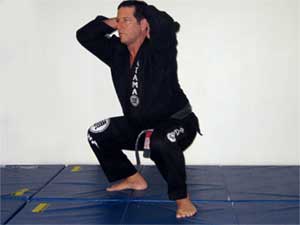Last week I discussed the differences between standing and kneeling guard passes. One thing I pointed out was that some schools tend use only kneeling guard passes whereas other schools tend to mix up their guard passing and use both standing and kneeling passes.
My BJJ coach Marcus Soares tends to prefer standing guard passes. What makes his passes different is that when he stands up in the guard his legs are NOT STRAIGHT – he actually squats down into a deep crouch position which lowers his center of gravity and makes it much harder to sweep him.
 His standing guard passing posture is very similar to the bottom position of the bodyweight squats that he loves to include in his legendary ‘warmups’ (the sixth exercise in this sequence).
His standing guard passing posture is very similar to the bottom position of the bodyweight squats that he loves to include in his legendary ‘warmups’ (the sixth exercise in this sequence).
Obviously endurance in the leg muscles is an asset to standing guard passes – if you legs get tired you will begin to straighten them, your center of gravity will rise and you will become ever more vulnerable to sweeps.
Here are some other things to keep in mind if you want to develop your standing guard passes:
- Do you know how to defend against the anklelocks and kneebars that your opponent might attack you with if you stand.
- How can you free your foot if your opponent cups your heel (one idea is discussed here).
- What are you going to do if your opponent underhooks your leg with his arm. One of my favorite responses is to drop that knee back down to the ground and attempt to apply the arm behind the back guard pass.
- How can you control your opponent’s hips while standing (i.e. the principle of caging the hips)
If you currently stay on your knees to pass the guard then I’d like you to consider developing one or two standing passes to be an ace up your sleeve for tricky situations. If you already use standing guard passes then I hope I’ve given you some food for thought to make your game better.
The post How to Stand in the Guard appeared first on Grapplearts.
